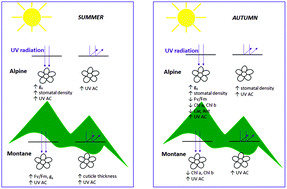当前位置:
X-MOL 学术
›
Photochem. Photobiol. Sci.
›
论文详情
Our official English website, www.x-mol.net, welcomes your
feedback! (Note: you will need to create a separate account there.)
Effect of UV radiation and altitude characteristics on the functional traits and leaf optical properties in Saxifraga hostii at the alpine and montane sites in the Slovenian Alps.
Photochemical & Photobiological Sciences ( IF 2.7 ) Pub Date : 2020-01-20 , DOI: 10.1039/c9pp00032a Tadeja Trošt Sedej 1 , Tina ErznoŽnik , Jerneja Rovtar
Photochemical & Photobiological Sciences ( IF 2.7 ) Pub Date : 2020-01-20 , DOI: 10.1039/c9pp00032a Tadeja Trošt Sedej 1 , Tina ErznoŽnik , Jerneja Rovtar
Affiliation

|
UV radiation affects the biochemical, physiological and morphological responses of plants. The effect is most pronounced at high altitude, such as alpine regions, and low latitude environments. The effect of UV radiation is impacted by different environmental conditions including temperature. We examined the response of the alpine plant Saxifraga hostii Tausch subsp. hostii growing at two altitudes (montane, 1100 m a.s.l. and alpine, 1500 m a.s.l.) in the Slovenian Alps. Selected ecophysiological, anatomical and pigment analyses along with measurements of the leaf optical properties were carried out during the growing season from July to September. Plants were grown under two different UV levels, near-ambient UV (UV) and reduced UV (UV-) radiation, and temperature conditions were monitored at both altitudes. Saxifraga hostii exhibited high photochemical efficiency of photosystem II and stomatal conductance under near-ambient UV radiation in August, which indicates that it is a well-acclimated plant. In September, photochemical efficiency was higher under reduced UV at the alpine altitude which together with a lower photosynthetic pigment content indicate delayed senescence for plants growing under reduced UV. Most leaf tissue thicknesses were not affected by UV radiation and altitude difference. There was a trend of increased stomatal density and reduced stomatal length on both leaf surfaces under near-ambient UV in August. However, there was no effect of UV attenuation or location at the alpine or montane site on the content of UV-B absorbing compounds, which implies the plant's tolerance of UV-B radiation. Saxifraga hostii leaves showed high absorption in the UV spectrum at higher altitudes, as shown by their optical properties. This study shows that Saxifraga hostii is well-acclimated to ambient UV radiation and to the environmental conditions at both altitudes. The effect of UV radiation is impacted by site conditions and this produces diverse plant responses, which contribute to the specific functional traits of Saxifraga hostii in the high-altitude environment.
中文翻译:

紫外线和海拔特征对斯洛文尼亚阿尔卑斯山高山和山地虎耳草的功能性状和叶片光学特性的影响。
紫外线会影响植物的生化,生理和形态反应。这种影响在高海拔地区(如高山地区和低纬度环境)最为明显。紫外线辐射的影响受包括温度在内的不同环境条件的影响。我们检查了高山植物虎耳草Tausch亚种的响应。斯洛文尼亚阿尔卑斯山的hostii生长在两个海拔高度(山地,海拔1100 m asl和高山海拔,1500 m asl)。在7月至9月的生长季节进行了选定的生态生理,解剖学和色素分析以及叶片光学特性的测量。使植物在两种不同的紫外线水平(接近室温的紫外线(UV)和降低的紫外线(UV-)辐射)下生长,并在两个海拔高度下监控温度条件。8月,虎耳草在近乎环境的紫外线辐射下表现出较高的光化学系统II光化学效率和气孔导度,这表明它是一种适应性强的植物。在9月,高海拔地区在紫外线降低的情况下光化学效率更高,再加上较低的光合色素含量,表明在紫外线降低下生长的植物的衰老延迟。大多数叶片组织厚度不受紫外线辐射和海拔高度差的影响。8月份,在接近室温的紫外线下,两个叶片表面的气孔密度都有增加的趋势,气孔长度减少了。但是,UV衰减或在高山或山地位置的位置对吸收UV-B的化合物的含量没有影响,这暗示了植物对UV-B辐射的耐受性。如其光学性质所示,虎耳草叶片在较高海拔的紫外线光谱中显示出高吸收性。这项研究表明,虎耳草(Saxfraga hostii)能够很好地适应环境紫外线辐射和两个海拔高度的环境条件。紫外线辐射的影响受场地条件的影响,这会产生多种植物反应,这有助于在高海拔环境下虎耳草的特定功能性状。
更新日期:2020-02-19
中文翻译:

紫外线和海拔特征对斯洛文尼亚阿尔卑斯山高山和山地虎耳草的功能性状和叶片光学特性的影响。
紫外线会影响植物的生化,生理和形态反应。这种影响在高海拔地区(如高山地区和低纬度环境)最为明显。紫外线辐射的影响受包括温度在内的不同环境条件的影响。我们检查了高山植物虎耳草Tausch亚种的响应。斯洛文尼亚阿尔卑斯山的hostii生长在两个海拔高度(山地,海拔1100 m asl和高山海拔,1500 m asl)。在7月至9月的生长季节进行了选定的生态生理,解剖学和色素分析以及叶片光学特性的测量。使植物在两种不同的紫外线水平(接近室温的紫外线(UV)和降低的紫外线(UV-)辐射)下生长,并在两个海拔高度下监控温度条件。8月,虎耳草在近乎环境的紫外线辐射下表现出较高的光化学系统II光化学效率和气孔导度,这表明它是一种适应性强的植物。在9月,高海拔地区在紫外线降低的情况下光化学效率更高,再加上较低的光合色素含量,表明在紫外线降低下生长的植物的衰老延迟。大多数叶片组织厚度不受紫外线辐射和海拔高度差的影响。8月份,在接近室温的紫外线下,两个叶片表面的气孔密度都有增加的趋势,气孔长度减少了。但是,UV衰减或在高山或山地位置的位置对吸收UV-B的化合物的含量没有影响,这暗示了植物对UV-B辐射的耐受性。如其光学性质所示,虎耳草叶片在较高海拔的紫外线光谱中显示出高吸收性。这项研究表明,虎耳草(Saxfraga hostii)能够很好地适应环境紫外线辐射和两个海拔高度的环境条件。紫外线辐射的影响受场地条件的影响,这会产生多种植物反应,这有助于在高海拔环境下虎耳草的特定功能性状。











































 京公网安备 11010802027423号
京公网安备 11010802027423号